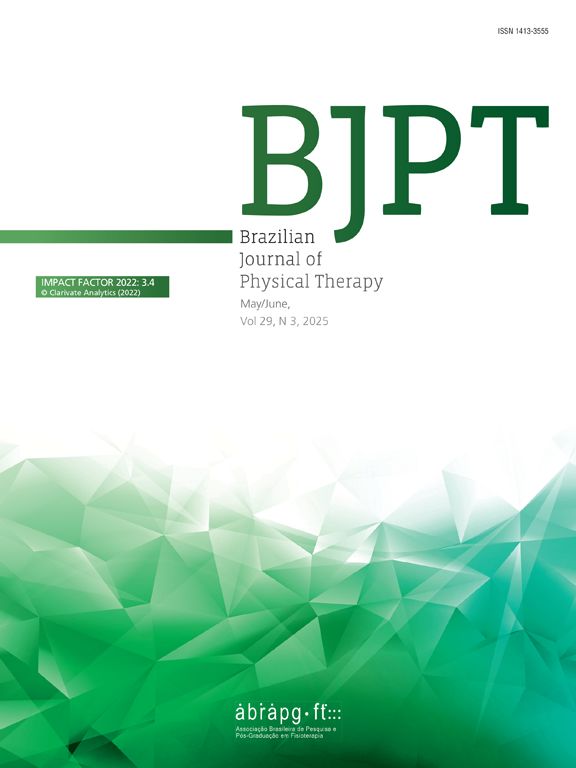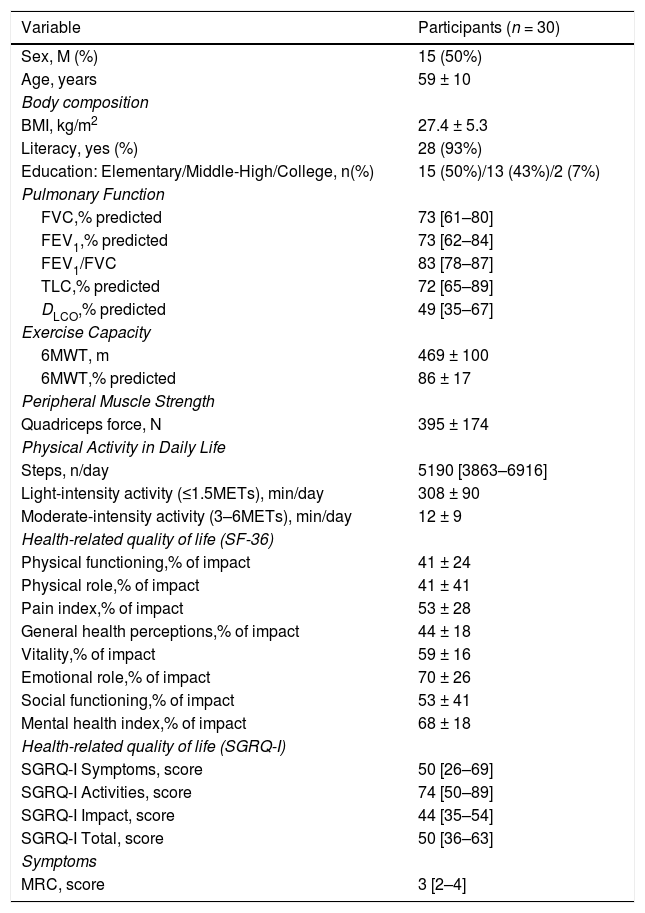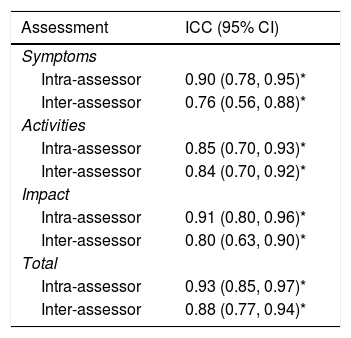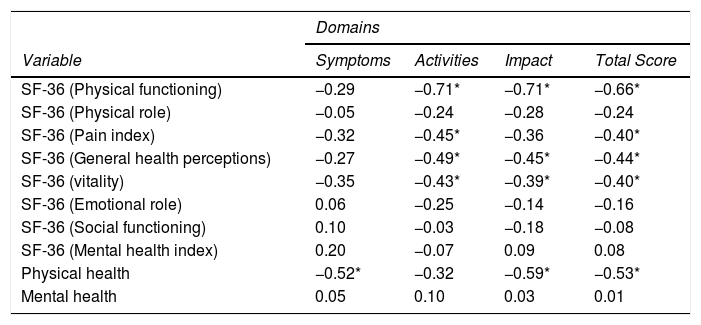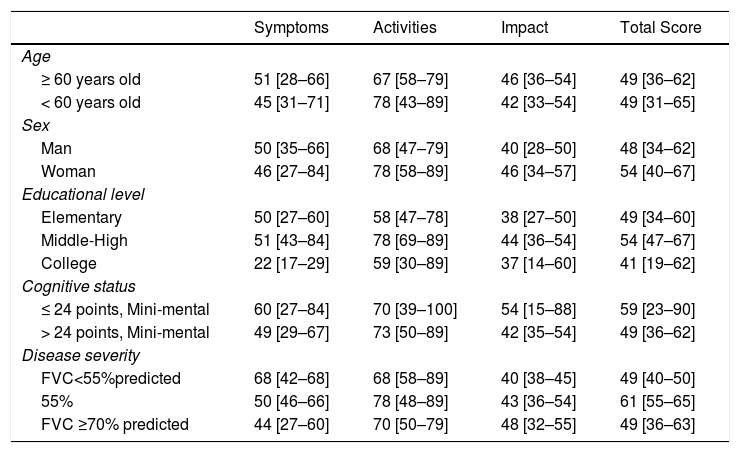The idiopathic pulmonary fibrosis-specific version of the St George's Respiratory Questionnaire (SGRQ-I) is a valid tool to assess health-related quality of life in patients with interstitial lung diseases (ILDs).
ObjectiveTo translate and cross-culturally adapt the SGRQ-I to Brazilian-Portuguese, and to assess its measurement properties.
MethodsPhase one consisted of the translation and cross-cultural adaptation of the questionnaire. In phase two, intra- and inter-assessor reliability (intraclass correlation coefficient [ICC]), internal consistency (Cronbach's α), minimal detectable change (MDC), ceiling/floor effects, convergent validity (correlation with SF-36 questionnaire), and discriminative validity (according to clinical characteristics) were investigated.
ResultsNo significant adaptations were needed during the translation process of the SGRQ-I. In phase two, 30 patients with ILD were included (15 men; age 59 ± 10 years; Forced Vital Capacity 73 [61–80]%predicted). The total score on the SGRQ-I presented excellent intra-assessor (ICC: 0.93; 95%CI: 0.85, 0.97]) and inter-assessor (ICC: 0.88; 95%CI: 0.77, 0.94) agreement. Internal consistency was considered adequate for the domains impact, activity, and total score (0.79<α<0.88) but not for symptoms (α=0.43). MDC was 12.8 points and ceiling/floor effects were found in only 3% of patients. No discriminative validity was observed, but there was adequate convergent validity.
ConclusionThe results provide preliminary evidence of adequate measurement properties and validity of the Brazilian-Portuguese version of the SGRQ-I for patients with ILDs.
Interstitial lung diseases (ILDs) are a heterogeneous group of pathologies with similar clinical, radiological, and functional characteristics. The occurrence of ILD varies with prevalence rates ranging from 17/105 to 80/105 and annual incidence rates ranging from 4.1/105 to 30/105.1–3 In Brazil, the incidence of interstitial pulmonary fibrosis is 0.4/10 per year, while the prevalence is 14/10.4 In addition to respiratory problems, patients with ILD show systemic manifestations that directly impact their quality of life.5
Although there is a vast number of generic instruments to assess health-related quality of life, better results are obtained when valid and specific instruments are used for targeted populations.6,7 The St George's Respiratory Questionnaire (SGRQ) was initially developed and validated to assess health-related quality of life in patients with chronic obstructive pulmonary disease (COPD).8,9 The SGRQ has acceptable validity and reliability to use in individuals with idiopathic pulmonary fibrosis.7 However, due to large clinical differences between patients with COPD and those with idiopathic pulmonary fibrosis, a specific English version of this questionnaire for this population, named the SGRQ-I, was developed.6 Although the SGRQ-I was specifically developed for patients with idiopathic pulmonary fibrosis, the clinical and functional similarities among the various subtypes of ILDs allows the use of the SGRQ-I for the broad group of ILDs. In fact, the SGRQ-I has recently been used as a clinical outcome in a randomized controlled trial investigating the effect of exercise training for patients with different ILDs.10
The SGRQ-I has been cross-culturally adapted into Spanish with adequate internal consistency, reliability, and validity.11 Likewise, the SGRQ-I may be valid for Brazilian patients with ILD; however, this has not been investigated. The aim of the present study was to translate and cross-culturally adapt the SGRQ-I to Brazilian-Portuguese and to test its measurement properties (i.e. reliability, validity, minimal detectable change (MDC), and ceiling/floor effects) in patients with ILDs.
MethodsStudy designThis methodological study was divided into two phases. In the first phase, we translated and cross-culturally adapted the SGRQ-I questionnaire to Brazilian-Portuguese. In the second phase, we investigated its measurement properties in patients with ILDs. The study was approved by the ethics committee of the Universidade Estadual de Londrina (Londrina, Paraná, Brazil) under the registry number #2.484.871. All patients provided written consent prior to participating in the study.
ParticipantsPatients diagnosed with ILD,12,13 age between 40 and 75 years, were recruited from the outpatient clinic of the University Hospital of the State University of Londrina (Londrina, Brazil). All patients had to present clinical stability for at least four weeks before the initial assessment and during the study. Participants' medical treatment and medication were monitored over the study period to identify potential changes in health status (e.g. exacerbations). Patients were excluded if they presented with cognitive deficits as identified with the Mini-Mental State Examination14 or if they presented any change in health status that could interfere with the assessments.
SGRQ-IThe original version of the SGRQ-I questionnaire has 34 items, divided into three domains: symptoms (6 items), activity (10 items), and impact (18 items). Scores can be calculated for the total questionnaire and separately for each domain. Each item has a specific weight. Total and domain scores range from 0 to 100, with higher scores indicating a more impaired health-related quality of life.6
Translation and cross-cultural adaptationThe translation of the English version of the SGRQ-I (EV1) to Brazilian-Portuguese followed the recommendations of the ISPOR Task Force for Translation and Cultural Adaptation of Patient-Reported Outcome Measures.15 The translation was done independently by two native Brazilian-Portuguese authors, both fluent in the English language. Both versions were then compared to each other, and the first Brazilian-Portuguese version (PV1) was created and tested in five patients with ILD. This procedure allowed the committee of experts, consisting of authors of the study (CAC and FP), and the researcher who developed the questionnaire (JY), to discuss and address any doubts or difficulties reported by the patients. The committee's role was to audit trail every step in the process of translation and cross-cultural adaptation as well as to provide solutions for problems occurring at this stage. After the analysis of PV1 by the committee of experts, the second Brazilian-Portuguese version of the questionnaire (PV2) was created. Then, PV2 was translated back into English (EV2) by a native Brazilian-Portuguese physical therapist who was fluent in English and had no prior contact with the original questionnaire. Subsequently, the original English version (EV1) and the back-translated version (EV2) were compared. Finally, small inconsistencies raised by the developer of the questionnaire were addressed in the final Brazilian-Portuguese version (PV3).
Assessment procedureIn the initial visit, all participants underwent a comprehensive clinical assessment. Lung function (whole-body plethysmography and diffusion capacity for carbon monoxide (DLCO), Vmax, CareFusion©) was evaluated following internationally accepted guidelines, and values were compared to normative data.16–20 Exercise capacity was assessed with the 6-minute walk test (6MWT).21,22 The 6MWT test was performed twice, and the highest achieved walking distance was recorded. Quadriceps strength was assessed by maximal voluntary isometric contraction (MVIC) of the dominant limb using a strain gauge (EMG System®, Brazil) attached to a stationary multigym device. Participants were instructed to perform the MVIC for six seconds, with 90° of hip and knee flexion.23 Symptoms of dyspnea were assessed using the Medical Research Council (MRC) scale (1–5 points),24 and health-related quality of life was assessed using the 36-item Short-Form Health Survey (SF-36).25 Physical activity in daily life was assessed using an activity monitor (Actigraph®, wGT3x-BT). Patients were instructed to use the activity monitor on their waist for six consecutive days, for 24 h, including sleeping time.26 Acceleration data were sampled at 30 Hz and analysed in 1-minute epochs. A complete data set was considered valid if the patient wore the activity monitor for at least 8 h/day for at least four weekdays.27 The intensities of activities were stratified according to metabolic equivalent of tasks (METs). Light-intensity activities were those demanding ≤1.5 METs while moderate-intensity activities were those demanding 3–6 METs.27 Outcomes related to physical activity in daily life included in the analysis were: daily steps and activities of light and moderate intensity.
For the reliability analysis, the SGRQ-I (which was researcher-administered) was applied at three time-points: initial visit and two additional visits. Each time-point took place with an interval of 5–7 days. This timeframe is considered adequate for not allowing participants to remember their answers and minimizing changes in participants' health status.28–30 The questionnaire was administered by two trained assessors, both physical therapists with at least four years of clinical experience. The use of two assessors allowed us to determine the intra- and inter-assessor reliability. The assessors were trained on how to perform interviews using verbal and non-verbal communication techniques to establish good rapport with patient. The questionnaire was always administered at the same place (a quiet and climate-controlled room) and at the same time of day to enhance standardisation of the procedure. Illiteracy is not uncommon among Brazilian patients with chronic respiratory diseases.31 So, given that scores may vary depending on how the questionnaire is administered (ie, self- versus researcher-administered), participants in this study were interviewed by two different assessors.30 Assessor 1 (WFA) applied the questionnaire in the first and third visits, while assessor 2 (HS) applied the questionnaire during the second visit. Misunderstandings and queries related to the questions were clarified according to the SGRQ-I application manual.6 The scores of the SGRQ-I obtained at each visit and the time required to complete the questionnaire at each visit were compared.
Finally, the SF-36 applied during the initial visit was used in the validation of the SGRQ-I (anchor-based method). It is a generic assessment tool to assess the quality of life that is easy to understand and apply. It is a multidimensional questionnaire that comprises 36 items, divided into eight domains: physical functioning, physical role, pain index, general health perceptions, vitality, social functioning, emotional role, and mental health index. Total score ranges from 0 to 100, where zero corresponds to the worst and 100 the best overall quality of life.25 The eight domains of the SF-36 are grouped into two major components: physical and mental. These scores vary from 0 to 50, in which the lower the score, the higher the physical and mental impairment. The SF-36 was chosen for the validation of SGRQ-I because it has been used in patients with ILD, and present acceptable construct and criterion validity to investigate the quality of life in this population.7,32,33
Statistical analysisDescriptive statistics were used to characterize the sample. Continuous variables were described as mean ± standard deviation, or median [interquartile range], depending on data distribution. The Statistical Analysis System (SAS) University Edition® was the software of choice to perform the statistical analysis.
Reliability analysisIntraclass correlation coefficient (ICC) and 95% confidence interval (CI) were used to determine the reliability of the questionnaire. The ICC selection followed the McGraw and Wong convention34 and the "two-way mixed effects, single measurement, absolute agreement" was used to investigate intra- and inter-assessor reliability. The reliability was classified as poor (ICC<0.5), moderate (0.5≤ICC<0.75), good (0.75≤ICC<0.9), or excellent (ICC≥0.9).35 Absolute reliability of the data was determined using the standard error of measurement (SEM). The SEM was calculated based on the intra-assessor reliability. The lower the SEM value, the more reliable the measurement.36 Cronbach's α coefficient was used to verify the internal consistency of the SGRQ-I. Values >0.7 were deemed acceptable.37 The MDC was calculated using the equation MDC=z−score×SD×√2(1−r) where the z-score represents the CI from a normal distribution (i.e. 1.96), SD is the standard deviation of the scores and r is the coefficient of the intra-assessor test-retest reliability (i.e. ICC).38 Ceiling and floor effects were calculated by estimating the percentage of patients whose scores lied within the 10% best (ceiling effect) or the 10% worst scores (floor effect) of the SGRQ-I.39
Validity analysisSpearman's correlation coefficient was used to verify construct validity (i.e. convergent validity). For the validity analysis, we correlated the total SGRQ-I score obtained in the initial visit with the score of the Physical Health component of the SF-36. We hypothesized that the SGRQ-I would show at least moderate correlation with the Physical Health component of the SF-36. The magnitude of this correlation is expected to be at least moderate (r > 0.39).40,41 We also conducted an exploratory analysis to investigate whether SGRQ-I score correlated with other measures, such as the Medical Research Council (MRC) scale, pulmonary function, and exercise capacity. Discriminative validity was done using a one-way ANOVA comparing groups of patients according to disease severity (i.e. i-Forced Vital Capacity, FVC<55%predicted; ii-55%42 Additionally, patients were stratified according to age, sex, educational level, and cognitive status (Mini-mental State Examination) and the SGRQ-I scores for each category were compared using student's t-test or Mann-Whitney test depending on data distribution. For the discriminative validity analysis, we hypothesized that the questionnaire would be able to detect differences according to disease severity but would not detect difference across the groups defined by age, sex, educational level, and cognitive status. A posteriori analysis was performed to assess the statistical power of the SGRQ-I validation with the score of the SF-36 physical domain. Power analysis was done using specific software (G*Power 3.1, University of Dusseldorf). Statistical significance was set at p < 0.05.
ResultsParticipants' characteristics are described in Table 1. Thirty patients diagnosed with ILD were initially assessed and considered eligible for inclusion in the study (15 men; mean age of 59 ± 10 years; median FVC = 73% [61–80] of the predicted value). The most prevalent diagnosis was idiopathic pulmonary fibrosis (n = 18), followed by pulmonary fibrosis related to diseases of the connective tissue (n = 5), diseases related to inhalation of particles (n = 4), and non-specific interstitial pneumonia (n = 3). Most of the participants were literate (93%) but had a low education level (i.e. 50% of them had only elementary education completed). The cross-cultural adaptation and translation of the questionnaire did not undergo significant changes except for item 4 of Section 5. The original question asks, "My breathing makes it difficult to do things such… play bowls or play golf". These two activities (bowls and golf) were excluded from the item as they were not applicable to Brazilian patients (Supplemental online material).
Characteristics of participants.
Data are presented as mean ± SD or median [interquartile range] or frequency (percentage) unless otherwise stated.
Abbreviations: 6MWT, six-minute walk test; BMI, body mass index; DLCO, carbon monoxide diffusion capacity; FEV1, forced expired volume in the first second; FVC, forced vital capacity; METs, Metabolic equivalent of task; MRC, Medical Research Council Dyspnoea scale; SF-36, Medical Outcomes Short-Form Health Survey quality of life questionnaire; SGRQ-I, Saint George Respiratory Questionnaire for patients with Interstitial Pulmonary Fibrosis; TLC, Total lung capacity.
The median length of time for completing the SGRQ-I during the initial, second, and third visits was 461 s [413–536], 476 s [430–552], and 422 s [368–470], respectively (p = 0.052). The median SGRQ-I total score for the 3 visits was 50 [36–63] points, 48 [38 −70] points, and 56 [40–68] points, respectively (p = 0.94). SGRQ-I domains and total scores for the initial visit are reported in Table 1. The total score of SGRQ-I had excellent intra-assessor (ICC= 0.93; 95%CI: 0.85, 0.97]) and inter-assessor (ICC = 0.88; 95%CI: 0.77, 0.94) reliability. Internal consistency analyses were deemed adequate for total score (Cronbach's α = 0.88), activity (Cronbach's α = 0.83), and impact (Cronbach's α = 0.79) domains but inadequate for symptoms domain (Cronbach's α = 0.48). The SEM for the total score was 6.5 points (or 13%) and the MDC was 12.8 points. The percentage of patients with maximum and minimum score were respectively 3% and 0%, indicating no ceiling and floor effects. Reliability date are provided in Table 2.
Reliability analysis of SGRQ-I.
Abbreviations: 95% CI, 95% Confidence Interval; ICC, Intraclass Correlation Coefficient; SGRQ-I, Saint George Respiratory Questionnaire for patients with Interstitial Pulmonary Fibrosis; r, Spearman's correlation coefficient. *p<0.05.
For the validity analysis, the total SGRQ-I score showed negative moderate correlation with the physical health component of the SF-36 (r = −0.53; p < 0.05). The full set of correlations between SGRQ-I and the domains of the SF-36 is provided in Table 3. There was no significant correlation between any domain of the SF-36 and SGRQ-I symptoms domains (−0.35≤r ≤ 0.20; p > 0.05 for all). The impact domain of the SGRQ-I correlated with the functional capacity, general health status, and vitality domains of the SF-36 (−0.71 ≤ r ≤ −0.39; p < 0.05 for all).
Correlations between the SGRQ-I and SF-36 questionnaire (anchor-based method).
SF-36: Medical Outcomes Short-Form Health Survey quality of life questionnaire; *p < 0.05.
The SGRQ-I was not able to discriminate health-related quality of life according to the disease severity, age, sex, educational level, and cognitive status (discriminative validity) (Table 4). Finally, the power analysis of the correlation between SGRQ-I total score and physical health component of the SF-36 was 0.83.
Discriminative validity of SGRQ-I for age, sex, educational level, cognitive status, and disease severity.
Data are presented as median [interquartile range]. Abbreviations: FVC, forced vital capacity. No significant differences were found across all categories (p > 0.05 for all).
SGRQ-I scores significantly correlated with the MRC (symptoms r = 0.42, p = 0.02; activity r = 0.71, p < 0.0001; impact r = 0.62, p = 0.0004; total score r = 0.66, p = 0.0001). There was no significant correlation between SGRQ-I scores and exercise capacity [−0.36 ≤ r ≤ −0.25; p > 0.05 for all], pulmonary function outcomes [−0.03 ≤r ≤ 0.20; p > 0.05 for all], and daily activities of light or moderate intensities (0.16 ≤r ≤ 0.30; p > 0.05 for all). Daily steps correlated significantly with symptoms of the SGRQ-I (r = 0.37, p = 0.04).
DiscussionIn the present study, the translated version of the SGRQ-I demonstrated good to excellent intra- and inter-rater reliability and good to excellent internal consistency. Further, the Brazilian-Portuguese version of the SGRQ-I is valid to be used in patients with ILDs. Consistent with previous work, the reliability analysis in this study demonstrated excellent values of ICC in most domains and total score.6,43 Yet, scores were somewhat higher in the intra-assessor analysis. The difference in total scores between assessors, however, was negligible with a clear overlap of the CIs. Also, in the intra-assessor analysis the scores of the second application were slightly higher, which suggests a learning effect. This, however, is not supported by the statistical analysis which showed adequate ICC values and no statistical difference between the assessments. The values of Cronbach's α confirmed the adequate internal consistency of the SGRQ-I except for symptoms (i.e. α < 0.7). In a systematic review of the psychometric properties of the SGRQ in patients with idiopathic pulmonary fibrosis, Swigris et al.33 also reported low values of internal consistency in the symptoms domain. A possible explanation for this is that questions related to symptom assess respiratory complaints that are not common in ILDs. For instance, items 4 and 5 of the first part of the questionnaire refers to "wheezing" and "respiratory crisis," symptoms more commonly reported by patients with obstructive lung diseases.
To the best of the authors' knowledge, this is the first study investigating the MDC of the SGRQ-I. This statistical approach helps clinicians to identify changes that are not merely a normal variation of the tool but instead changes in the clinical condition of the patient.44 It, however, does not mean that changes on MDC superior to 12.8 points are considered clinically relevant for patients. Future studies are needed to determine whether this cut-off resembles clinically relevant changes in patient's quality of life.
Recently, Prior and colleagues45 demonstrated that less than 15% of patients with ILDs reached highest (celling effect) or lowest (floor effect) deciles of possible scores on the SGRQ-I. Consistent with these results, our findings also did not identify a significant proportion of patients with maximal/minimum scores in the questionnaire (i.e. less than 5% of patients). Albeit these results should be confirmed in larger sample size, this is a good indication that the tool is not limited by construct constraints.
The analysis of the construct validity of the SGRQ-I or Brazilian-Portuguese language presented similar values to those observed in the validation of the English version.6 These results confirm that the translation and the cross-cultural adaptation in the present study did not impact on the essence of the questionnaire. Indeed, there was no need to adapt the text during the translation process significantly. Only item 4 of the fifth section was changed due to environmental and cultural differences, as reported in the results section. Importantly, the questionnaire was designed to be applied in idiopathic pulmonary fibrosis. The present study expands the results of the reliability and validity of the SGRQ-I questionnaire for utilisation in patients with ILD.
The analysis of discriminative validity showed that it was not possible to anticipate a better or worse quality of life based on age, sex, educational level, cognitive status, and the severity of the disease. This finding, however, needs to be interpreted with caution. The sample size of the present investigation was not powered for this analysis, and these results likely change if using a larger sample size. Additional validation analyses were recently published using the English version of the SGRQ-I and confirmed that it was good at discriminating patients with different stages of the disease.45
Similar to Capparelli et al.,11 we also found a significant correlation between SGRQ-I and MRC scores. Conversely, none of the other investigated outcomes presented significant correlations. This is not particularly surprising as the SGRQ-I also failed to show strong correlations of the same outcomes in the validation study for the English language.6 Lubin et al.46 demonstrated that dyspnea was one of the strongest determinants of health-related quality of life in patients with idiopathic pulmonary fibrosis, being superior to disease severity. In other respiratory diseases, a reduced exercise capacity present meaningful relationship with health-related quality of life, especially in more severely affected patients.47 The sample in the present study did not include many patients with marked reduction of exercise capacity or muscle strength. It is possible to hypothesise that the lack of correlation between SGRQ-I and 6MWT is a consequence of the preserved muscle function in the assessed patients.
The results of the present study need to be interpreted in light of some potential limitations. First, the sample size is somewhat small. The low prevalence of patients with ILD and the monocentric design of the present study have limited participant recruitment. However, other authors found acceptable results with a similar sample size.11 But, the post-hoc power analysis of the SGRQ-I validation (power=0.83) confirmed the sample size of the present study did not hamper the interpretation of our results. Second, the questionnaire was applied in patients with different types of ILD, despite the original version being specifically developed for patients with idiopathic pulmonary fibrosis. Although 60% of the study sample was comprised of people with idiopathic pulmonary fibrosis, our results were similar to the previous study on the validity of SGRQ-I.6 Also, investigating the validity of SGRQ-I in specific diseases was beyond the scope of the present study. Third, in the process of translation and cross-cultural adaptation of questionnaires, the backward translation should ideally be performed by two independent researchers. Finally, the SGRQ-I was initially developed to be self-administered. In the current study, questionnaires were researcher-administered. This was done as we anticipated patients with low literacy levels to be included in the present study. Given there is considerable variation of scores when questionnaires are self- versus researcher-administered, we attempted to reduce bias by standardising the application method.31
ConclusionThe Brazilian-Portuguese version of SGRQ-I, albeit conducted in a relatively small sample, seems to have adequate measurement properties justifying its use in the Brazilian population.
Conflicts of interestNone of the authors have conflicts of interest to declare.
WFA was receipient of Fundação Araucária/Brazil fellowship. HS, TG and LCM were reciepients of CAPES/Brazil fellowships. CAC is supported by FUNADESP, Brazil. VC is supported by Cancer Council NSW/Australia. The study was partially funded by CNPq, Brazil (426509/2018-8).
Este questionário é desenvolvido para nos ajudar a compreender até que ponto a sua condição respiratória perturba você e como isso afeta sua vida. Nós o utilizamos para descobrir quais os aspectos da sua doença que causam mais problema. Estamos interessados em saber o que você sente e não o que os médicos, enfermeiros e fisioterapeutas pensam que você sente.
Leia atentamente as instruções com atenção e pergunte caso não entenda algo. Não gaste muito tempo em suas respostas.
Nome: ……………………………Data: ………………
ID: ………………………
Idade: …………………Sexo: () Masculino () Feminino
Marque uma das opções que mostra como você considera seu estado de saúde atual.
Copyright reserved
P.W. Jones, PhD FRCP
Professor of Respiratory Medicine,
St. George's University of London,
Jenner Wing,
Cranmer Terrace, Tel. +44 (0) 20 8725 5371
London SW17 ORE, UK. Fax +44 (0) 20 8725 5955
Nas questões abaixo, assinale aquela que melhor identifica seus problemas respiratórios atualmente. Por favor, assinale com um “X” em um dos quadrados de cada questão abaixo.
5. Durante uma semana típica, quantas vezes você tem crises respiratórias: Por favor assinale uma resposta:
□ Mais de uma crise □ Nenhuma crise
6. Durante uma semana típica, quantos dias bons você tem? (ex: sem problemas respiratórios): Por favor assinale uma resposta:
□ Nenhum dia □ Alguns dias □ Todos os dias são bons dias
Seção 1: Se você já teve um trabalho remunerado, assinale um dos quadrados:
Minha condição respiratória interfere ou me fez parar de trabalhar □
Meu problema respiratório não afeta meu trabalho □
Seção 2: As perguntas abaixo referem-se às atividades que normalmente provocam falta de ar em você.
Por favor, assinale com um “X” no quadrado de cada questão abaixo, indicando se você sentiu falta de ar em alguma dessas atividades atualmente:
Seção 3: Mais algumas perguntas sobre a sua tosse e a sua falta de ar.
Por favor, assinale com um “X” no quadrado de cada pergunta abaixo de acordo com o seu caso atualmente.
Seção 4: Perguntas sobre outros efeitos que o seu problema respiratório possa ter causado em você.
Por favor, assinale com um “X” no quadrado de cada pergunta abaixo de acordo com o seu caso atualmente.
Seção 5:
As perguntas seguintes se referem às atividades que podem ser afetadas pela sua condição respiratória.
Por favor, assinale com um “X” no quadrado de cada pergunta abaixo no qual acredita se aplicar melhor a você por causa da suacondição respiratória.
Seção 6: Gostaríamos de saber o quanto sua condição respiratória geralmente afeta suas atividades do dia-a-dia. Por favor, assinale com um “X” no quadrado de cada questão abaixo, indicando a que melhor se aplica a você por causa da suacondição respiratória.
Agora, por favor assinale com um “X” a resposta que melhor define a forma como você é afetado pela sua condição respiratória:

